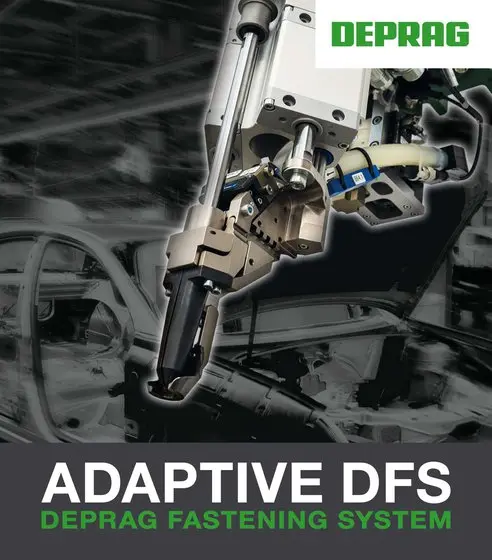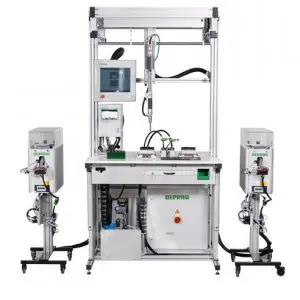Adaptive Sheet Metal Screwdriving Unit


Torque controlled screw tightening has always been the most reliable and easily applied method to produce a quality screw joint. But is torque control really going to give the perfect assembly every time?
Firstly, what is a perfect screw joint? What do we want to achieve by assembling a screw in a product?
We normally need to join two parts together, but more than that we want to induce tension in the joint so that the parts do not come apart. Sometimes we also need to seal the parts together to prevent leakage or keep dust and water out.
So the aim for a screw joint is not simply to assemble the screw to a target torque within a set tolerance, but it is to induce a constant clamping or pre-load force.
When we apply torque to a screw joint we can calculate the amount of tension induced in the joint assuming that there is no friction in the joint. In a low friction assembly (eg machine thread screw into a pre-tapped hole) almost all of the torque will induce tension in the joint. If you know the pitch of the thread and the torque applied you can then calculate the tension.
Fluctuating screw-in torque influences pre-load force!
What about thread forming and self tapping screws? We know that a portion of the torque is lost to friction and by doing some analysis we can subtract the friction and figure out the average torque used to clamp the parts. In most cases this will be enough, but what if the friction is not the same in every assembly?
What if a screw with a thread diameter at the high end of it’s tolerance meets a part with a hole dia that is at the low end of the tolerance? In this case less torque will be used to clamp the joint and it may not be enough. At the other end of the spectrum, there could be too much torque which could strip the joint or damage the part.
The solution is Friction Tightening. The advent of EC and EC servo screwdrivers has paved the way to improving the quality of screw joints. Today we can assemble the screw, calculate the friction torque and then add the pre-determined tightening torque. So if the friction torque varies, the actual clamping torque and consequently the clamping force will still be constant on every assembly.
Using the friction torque measurement we cannot use the final torque for statistical analysis anymore. The final tightening torque is the sum of the friction torque and the clamping torque the final torque accuracy will depend on the quality of the joint and the screws. We now have to look at the clamping torque only for statistical analysis.
The friction torque method is already well established in the international automotive industry as well as the electronic, mobile technology, household goods and medical industries.
Friction tightening modules are optionally available on Deprag’s Hand Held programmable screwdrivers and machine mountable electric screwdrivers.
For more information or if you would like to discuss an application, please don’t hesitate to contact us.
Fully automated assembly systems not only offer fast assembly, but they also guarantee a higher level of quality control. Unfortunately, professionally designed, reliable automated assembly equipment is expensive and often inflexible. Unless there are very large volumes over a length of time, many automatic assembly automation projects are not viable.
The solution? Intelligent – Manual – Assembly cells.
Increasingly manufacturers are finding a middle ground between hand assembly and fully automated assembly cells. Unknown product life cycles, unpredictable demand and sudden downturns means that manufacturers are looking for the most flexible system possible. With modern screwdriving, screwfeeders and controllers we able to guarantee complete process control, minimize assembly time and provide flexibility at the same time.
A typical Intelligent Manual Assembly Cell will consist of one or more hand guided screwdrivers mounted in a position control stand connected to one or more screw feeders.
Peter Smith, production engineer at a well-known manufacturer of heating control units explained his requirements:
“Our heating control units are available, according to type and size of heating system, in the most varied of designs. With the recent introduction of our new control units we are starting three separate series, our HCU25, HCU50 and HCU100. When launching our new series onto the market we are unable to estimate the expected production amounts accurately. It is also difficult to plan out how the quantities required of each individual version will develop in relation to one other. It is for exactly this reason that we require highly flexible assembly equipment. Ideally production should be able to be simply, reliably and economically adapted to each of the product versions. Additionally for our HCU assembly we have the highest requirements for processing reliability as is usual for electronic components. The sequential order of assembly must be guaranteed and each step must be documented and integrated into our manufacturing execution systems”.
Normally this requirement of a strict sequence and documentation calls for automation. However in the costs of automation and unknown production numbers excluded automation.
Deprag were able to offer an intelligent manual assembly cell that could be used to assemble all three HCU’s even though they each used different parts, sequence of assembly, different screws and torques.
Using interchangeable adapters, assembly can be easily converted to the various sizes of HCU25, HCU50 and HCU100. Work piece adapters are equipped with integrated sensor technology and communicate with a superior controller.
Furthermore the assembly required ESD safe and technical cleanliness. The screws were fed with sword feeders instead of vibratory feeders and the assembly and positioning of the screws was done with vacuum pick up and particle killers.
Mr Smith says –
“The collaboration with DEPRAG has been impressive. All our technical requirements were realised with already existing harmonised standard components within the shortest space of time. And what is particularly important for us, all system components come to us from one source. When we need to increase our production capacity we can flexibly expand our assembly line”.
If you would like to know more, or to discuss your project, please contact us here.
Almost every component of a product has a specification with an acceptable tolerance. The component will have functional and physical attributes that can be measured and specified. If the attributes are outside of the predetermined tolerance it will be rejected.
Screw joints are integral parts of any assembly. Loose or stripped screws at best can cause annoying rattles and in a worst case they can cause complete failure of a product. In any case, the long term costs of warranty repairs and harm to a brand will far outweigh the short term costs of correctly designing and specifying the torque, accuracy and type of screwdriving equipment for your assembly line.

Manual Screw Driving station with Automatic screw feeding and position control
Quite often we still find that many manufacturers do not have a torque specification for each of their screw assemblies, let alone calibrate their precision screwdriver or monitor their accuracy. Many screwdrivers in production have no torque control or are easily adjusted by the production line workers, while others are simply not checked until something goes wrong (oops too late!!).
“As long as the screw is not stripped”, “As long as a screw is there” are phrases our sales engineers often hear when they ask about the torque specifications. Unfortunately that is not good enough these days. There is no way of knowing if a screw is stripped after assembly unless there is some kind of supervision system or the operators care enough to reject the part as it happens. Just because an inspector sees that all of the screws are assembled does not mean that they are all assembled to torque or not stripped. Testing every screw after assembly with a torque wrench is a waste of time and inaccurate, especially when you can get screwdrivers that assemble screws more accurately than any subsequent testing method.
Customers expect more from Australian manufactured goods. You can imagine the disappointment of a customer who has chosen Australian made products and finds that it is faulty because of something as simple as a stripped or loose screw? He would probably think he may as well have bought the Chinese product for a fraction of the price. What if that company was one of your main export customers?
What’s the solution?
We recommend that manufacturers:
How accurate do the screwdrivers need to be?
This depends on the tolerance that is required. Generally industry expects a failure rate of better than 0.6 failures per million assemblies. If the screwdriver is capable of a standard deviation (accuracy) of less than ±3% with a torque tolerance of ±10% of the target torque, then we can safely meet the failure rate of 0.6 per million. If the screwdriver can achieve an SD of better than ±1% (for example our EC Servo Screwdrivers), then a tolerance of ±5% is possible.
We have over 20 years experience in helping customers with screw assembly productivity and quality control issues. Please don’t hesitate to contact us for advice on your applications.